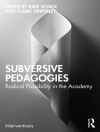Seal the gaps in student learning with targeted intervention
Research on positive behavior support has focused largely on tier one, school-wide disciplinary policies, and tier three interventions tailored to highly problematic students. This leaves a gap in the middle. ‘Yellow zone’, or tier two, interventions are an extremely effective way to address many challenging behavior and disciplinary issues in small group settings.
Positive Behavior Support at the Secondary ‘Targeted Group’ Level shows teachers how to identify the students who can benefit from tier two interventions and demonstrates how to create an implementation plan that delivers results. Focusing on proactive strategies rather than reactive solutions, Riffel and Mitchiner’s research-based techniques include:
- General strategies that can be applied at the individual student level, such as self-management, proximity control, and the Premack principle and peer mentoring
- Comprehensive action plans that anticipate the full range of disruptions that may occur
- A useful behavior rating sheet proven effective in improving student behavior
- ‘Funk Sway’ For The Classroom: Using Feng Shui principles to create a classroom environment that enhances productivity, learning, and creativity
Apply the techniques in this book to reduce challenging behavior, improve school climate, and improve outcomes for ALL students.
‘This book is easy to read, understand, and implement in any classroom or school. Teachers will be drawn to the resources that can be copied and used immediately! I can’t wait to apply some of these practices in my classroom!’
Rachel Spenner, Sixth Grade Teacher
Westridge Elementary School
Mục lục
About the Authors
1. Introduction
2. Increasting Structure and Predictability in the Classroom Through Behavior Management
3. Which Came First: The Behavior or the Academic Struggle?
4. Which Students Need Booster Shots?
5. What Do You Do With the Students Swinging From the Chandeliers?
6. Fail to Plan, Plan to Fail: What Are Your Lines of Defense?
7. How Do You Get Students to Prefer Good Behavior?
8. How Do You Engage and Connect With Students?
9. How Do You Get ‘Funk Sway’ in the Classroom?
10. Why Is Change So Hard?
11. How Do We Change the Consequences?
12. What Are Function-Based Interventions?
13. How Do I Follow the Navigational Map?
14. Sample Intervention Forms
Giới thiệu về tác giả
Melinda Mitchiner is currently completing her doctoral work in Special Education at the University of Kansas, Lawrence, KS. She is also coordinating technical assistance for the national technical assistance center for inclusive schoolwide school reform. Before her arrival at the University of Kansas, Melinda spent many years teaching and providing support for students who exhibit challenging behaviors. She provided professional learning opportunities at the school, district and state levels for educators and others to promote implementation of positive behavior support.












